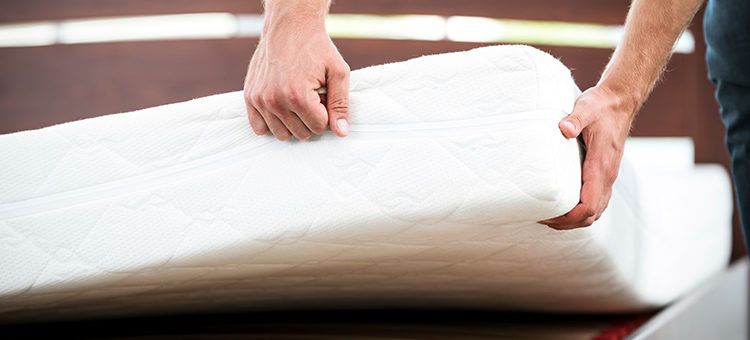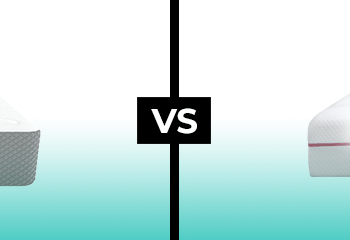
Choosing Mattress Firmness: What’s Right for You?
We are owned and operated by GoodMorning.com. We hire 3rd-party engineers and use public data to rate mattresses on over 30 criteria that we believe are important. Brands we own—Douglas, Juno, Octave, Logan & Cove, and Novosbed—are reviewed and advertised where indicated. Views expressed here are our opinions only. Full details.
Everybody knows when a mattress is way too firm for them. Equally, lying down on a mattress that is far too soft for our taste yields a swift judgment. But for most people, there is variation and nuance to our taste. What’s more, there are dozens of reputable mattress brands on the market right now, selling hundreds of mattresses, many of which have varying firmness options. Therefore, choosing a mattress firmness isn’t easy — especially if you are ordering online. With all that in mind, we’ve put together a guide to simplify the essentials of mattress firmness!
Body weight and spinal alignment are two factors to consider when buying a mattress. When it comes to weight, people with a greater BMI sink further into a given mattress, while people with a lower BMI will sink considerably less. Mattresses are carefully designed to apply pressure that will provide comfort and support. If a heavier person sinks too far into a mattress, they may not have enjoyed all the benefits a particular mattress boasts. They might also find it harder to get out of bed if they sink right through the foams.
Lighter people too may ‘float’ above the denser support foams that are designed to provide good spinal alignment and support. As such, a useful guide for choosing mattress firmness is the assumption that the ‘soft’ option for a mattress is designed for lower BMI, the ‘medium’ option is suited to average BMI, and the ‘firm’ option is for higher BMI.
But this BMI rubric is not a hard fact, because it does not take into account personal tastes for comfort. Nor does it consider all aspects of back support. Nobody likes waking up with a sore back. But sleeping on a mattress that lacks appropriate support for your spine is a common cause of back pain.
Sleeping with a naturally aligned spine is an excellent way to reduce back pain and get the most out of your mattress. While sleeping, we all relax our back muscles, and the healthy alignment our backs require is not guaranteed when we’re lying down. In fact, it’s up to mattresses to provide the spinal alignment our bodies crave.
Whether you lie on your stomach, your side, or your back, your spine is affected. The spine has a natural curve, so it needs lumbar support. Likewise, side sleepers can develop back problems because their hips and shoulders sink into the mattress. If the sinkage of these body parts isn’t appropriate, the spine may twist or sag, and it becomes more likely that the sleeper will experience daytime pain.
Stomach sleepers, with their tummies pushing into the mattress, generally support their spines best with a firmer mattress. While side sleepers get the right amount of support on their pressure points with a softer mattress, back sleepers can get good support across their backs on soft, medium, or firm mattresses. Other factors, like body weight and personal taste, are often the deciding factors when back sleepers choose a mattress firmness.
Innerspring mattresses have a broad range of firmness levels. Manufacturers can adjust the coil count, coil thickness, and coil type to offer many, many levels of firmness. What’s more, many innerspring mattresses – even firm ones – come with pillowtop sleep surfaces that provide a plush bed with great support.
Memory foam, like innerspring mattresses, comes in a range of firmness and softness options. The science behind the firmness of a memory foam mattresses isn’t as simple as looking at the thickness of a coil. In fact, memory foam has a chemical construction that allows it to react to the heat and pressure of a sleeper. The foam molds itself to the sleeper. When the sleeper gets out of bed, the foam cools, and the bed returns to its original shape!
The firmness of a memory foam mattress depends on how the different layers are constructed. Foam density and foam quality all affect how much support a mattress provides. On a memory foam mattress, a sleeper will sink in further at the body’s pressure points. Hips and shoulders, for example, will sink to comfortable levels for side sleepers. The even firmness of a memory foam mattress helps support pressure points and helps the spine stay more naturally aligned.
To suit a sleeper’s BMI or sleep position, memory foam mattresses have a range of firmness options, just like innerspring mattresses. The science of memory foam makes it incredibly versatile concerning support and comfort options. Many manufacturers provide a ‘universal comfort’ model, rather than a soft / medium / firm range. That’s because the layers of foam in these mattresses have versatility. They provide comfort and support with an even, medium firmness.
Handy Tips for Firmness Shopping
Shop according to your sleep position and body type, and pay attention to the reviews your mattress candidates have received. But remember, mattresses, like shoes, take some breaking in. How a mattress feels in a store may not be how it feels after you have slept on it for a few months.
As such, you should take advantage of the remarkable changes that have occurred in the mattress industry over the last few years. Buy from companies that offer long sleep trials and full money-back guarantees. Many high-street stores have exchange-only policies, and they expect you to decide on firmness and comfort in the store. That’s unreasonable. And if you are looking for precise comfort, consider purchasing from a company that offers a free topper for firmness adjustments.
Ready to find your mattress with the right firmness? Check out our list of Best Mattresses.

